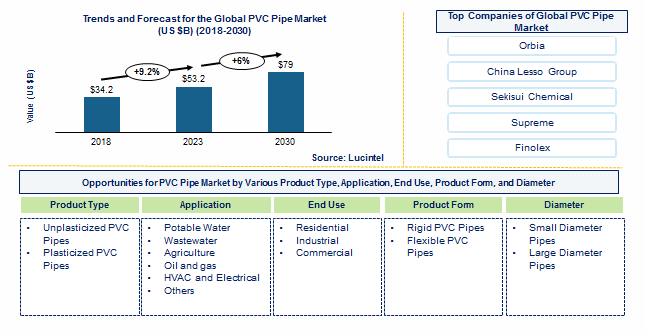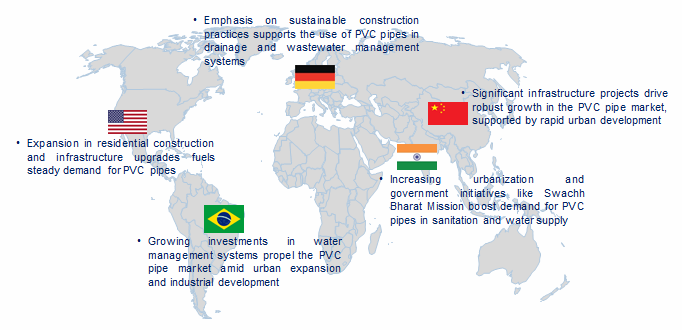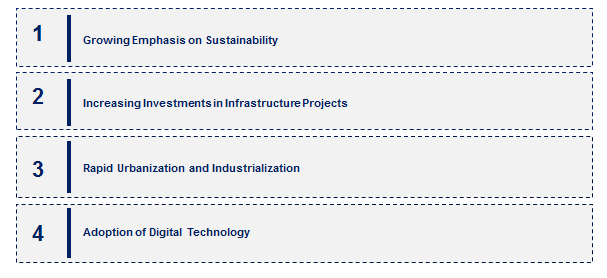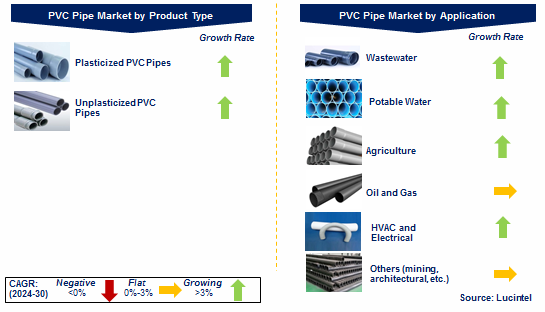The future of the global PVC (Poly Vinyl Chloride) pipe market looks promising with opportunities in the residential, industrial, and commercial construction industries. The global PVC pipe market is expected to reach an estimated $79 billion by 2030, and it is forecast to grow at a CAGR of 6% from 2023 to 2030. The major drivers for this market are growth in residential and non-residential construction activities and replacement of aging pipelines.

PVC (polyvinyl chloride) pipes are primarily made from vinyl chloride monomer (VCM), a chemical derived from ethylene and chlorine. The production process involves polymerization of VCM to form PVC resin, which is then mixed with additives such as plasticizers, stabilizers, and pigments to enhance flexibility, durability, and color. Calcium carbonate is commonly used as a filler to reduce cost and improve mechanical properties. These raw materials undergo extrusion or injection molding to shape into pipes of various sizes and types, serving diverse applications in plumbing, construction, and industrial sectors globally. The price of PVC pipes in the market varies based on factors such as size, quality, and geographical location. Prices can fluctuate due to raw material costs, manufacturing processes, and market demand, influencing competitiveness among different pipe materials.
-
Lucintel forecasts that plasticized PVC pipes will remain the largest segment and it is also expected to witness the highest growth over the forecast period due to its heat and chemical resistance properties.
-
Within the global PVC pipe market, wastewater will remain the largest application over the forecast period due to the increasing urbanization and development of infrastructure.
-
APAC will remain the largest region and it is also expected to witness the highest growth over the forecast period due increasing urbanization, infrastructure development, and the continuous growth of the residential construction.
Country Wise Outlook for the PVC Pipe Market
The PVC pipes market is indeed experiencing significant growth globally, fueled by increased demand from various industries such as construction, agriculture, water supply, and sanitation. Major players in the market are expanding their operations and forming strategic partnerships to strengthen their positions. Below image highlights recent developments by major PVC pipes market producers in key regions: the USA, China, India, Brazil, and Germany.

Click Here to Know more about Regional Or Country Market Reports
Emerging Trends in the PVC Pipe Market
Emerging trends in the PVC pipe market shaping its future applications and market dynamics:
-
Growing Emphasis on Sustainability: There is a growing emphasis on sustainability across industries, including construction. PVC pipes are increasingly being scrutinized for their environmental impact throughout their lifecycle. This has led to innovations in recycling PVC and reducing the carbon footprint of production processes.
-
Increasing investments in infrastructure projects: Increasing investments in infrastructure projects, especially in developing regions, are driving demand for PVC pipes in water supply, sanitation, and construction applications.
-
Rapid Urbanization and Industrialization: Rapid urbanization and industrial growth in emerging economies are boosting the demand for PVC pipes for urban water management, industrial fluid transport, and building drainage systems.
-
Adoption of digital technology: Adoption of digital technologies such as IoT (Internet of Things) for smart water management systems and remote monitoring of pipelines is gaining traction, enhancing operational efficiency and maintenance of PVC pipe networks.

A total of less than 200 pages has been developed to help in your business decisions. Sample figures with some insights are shown below.

Recent Developments by the PVC Pipe Market Suppliers
Recent developments in PVC pipe by various companies highlight ongoing innovations and advancements across different sectors:
-
Sustainability Initiatives: There is a strong emphasis on recycling and reducing the environmental footprint of PVC pipes through innovative recycling technologies and the use of sustainable materials.
-
Advancements in Material Technology: Manufacturers are developing PVC pipes with enhanced durability, improved chemical resistance, and better performance characteristics to meet diverse application needs.
-
Market Expansion: Growing construction activities, particularly in infrastructure projects, are driving the demand for PVC pipes globally.
-
Regulatory Trends: There is a shift towards stricter regulations promoting safer manufacturing practices and eco-friendly products, influencing industry standards and product development.
-
Technological Innovation: Adoption of digital technologies for manufacturing processes and product design is increasing efficiency and product quality in the PVC pipe industry.
Strategic Growth Opportunities for PVC Pipe Market
The PVC pipe market is very dynamic due to its unique properties of being durability and longevity, cost-effectiveness and versatility. Some key strategic growth opportunities for this market include:
Infrastructure Development and Urbanization
-
One of the primary growth drivers for the PVC pipe market is infrastructure development, particularly in urban areas. PVC pipes are widely used in water supply, sewage systems, and drainage networks due to their durability, corrosion resistance, and cost-effectiveness. As urbanization continues to expand globally, there is a growing demand for reliable and efficient piping solutions to support modern infrastructure projects. Strategic opportunities lie in supplying high-quality PVC pipes for new construction projects and infrastructure upgrades, catering to the increasing urban population's needs.
Technological Advancements and Innovation
-
Innovations in PVC pipe manufacturing have introduced enhanced materials and production techniques, improving product performance and sustainability. Advanced formulations of PVC pipes offer increased flexibility, higher tensile strength, and improved resistance to chemicals and abrasion. Moreover, innovations in jointing systems and installation methods have simplified construction processes, reducing labor costs and project timelines. Strategic growth opportunities include investing in research and development to further enhance PVC pipe properties, innovate new applications, and expand market penetration into niche sectors such as industrial piping and telecommunications.
Water Management and Conservation
-
Water scarcity and the need for efficient water management solutions drive the demand for PVC pipes in agricultural irrigation, water distribution networks, and rainwater harvesting systems. PVC pipes are favored for their smooth interior surface, which minimizes friction loss and ensures optimal water flow efficiency. Strategic opportunities exist in promoting PVC pipes as a sustainable choice for water conservation initiatives, supporting initiatives aimed at reducing water wastage and improving water quality. Additionally, leveraging PVC's recyclability and promoting eco-friendly practices in manufacturing processes can enhance market competitiveness and meet regulatory sustainability goals.
Market Expansion in Emerging Economies
-
Emerging economies are experiencing rapid industrialization and urban development, presenting significant growth opportunities for the PVC pipe market. Countries in Asia-Pacific, Latin America, and Africa are investing in infrastructure projects to support economic growth, urbanization, and population expansion. Strategic initiatives include establishing local manufacturing facilities, forming partnerships with regional distributors, and adapting product offerings to meet specific market demands and regulatory requirements. This approach not only facilitates market expansion but also strengthens supply chain resilience and reduces transportation costs.
Sustainability and Environmental Compliance
-
Increasing regulatory focus on environmental sustainability and stringent standards for construction materials drive the adoption of PVC pipes. Manufacturers are responding by developing PVC pipes with reduced environmental impact, incorporating recycled materials, and improving energy efficiency during production. Strategic growth opportunities include obtaining certifications for sustainable practices, educating stakeholders on the environmental benefits of PVC pipes, and collaborating with regulatory bodies to influence industry standards.
PVC Pipe Market Driver and Challenges
PVC pipe has a very important role in many industries including water distribution, sewage systems, and underground utilities due to their durability, corrosion resistance, and ease of installation. In agriculture, PVC pipes support efficient irrigation systems, ensuring optimal water management and enhancing crop yields while minimizing water wastage.
The factors responsible for driving the PVC pipe market include:
-
Cost-Effectiveness and Durability: PVC pipes are highly regarded for their cost effectiveness relative to conventional materials such as metal or concrete. They possess exceptional resilience, resistivity towards corrosion and have a long service life, which is why they have found use in different areas of application such as water supply sewage and industrial piping.
-
Infrastructure Development: The demand for PVC pipes is driven by increasing investments in infrastructure projects especially in emerging economies and urban centers. These pipes play a critical role in water distribution networks, drainage system agriculture irrigation among others that support development of cities and economic growth.
-
Technological Advancements: Innovations in PVC pipe manufacturing have enhanced product performance and installation efficiency. Advanced formulations increase such characteristics as impact resistance, flexibility or chemical resistance expanding its scope of applications into industries such as telecommunication or automotive.
-
Growing Demand for Irrigation and Water Management: Because the interior surface is smooth; it reduces friction loss making them ideal materials to be used in agricultural irrigation systems. Moreover, the rising emphasis on conservation of water and implementing effective management practices further contributes towards boosting demand for PVC pipes in irrigation as well as rainwater harvesting uses.
Challenges facing the PVC pipe market are:
-
Environmental Concerns: There has been a lot of questioning regarding PVC pipes because there are concerns about environmental impacts at the time of production and disposal. This includes using chlorine during manufacture among other issues that generate hazardous by-products during production processes. To address these problems it would mean practicing sustainable methods of operation, reducing the impacts on environment besides encouraging recycling programs.
-
Regulatory Compliance: Manufacturers of PVC pipes face challenges with regard to compliance on quality control regulations especially those related to safety standards required as well being environmentally friendly. Fulfilling regulatory requirements across diverse regions add complexity to processes besides leading to an escalation operational costs.
-
Competition from Alternative Materials: Other materials such as HDPE (high density polyethylene), PEX (cross-linked polyethylene) or ductile iron compete with the use of PVC pipes. They offer such benefits as flexibility, better resistance to temperature changes and low environmental impact thus threatening PVC’s market share in certain applications.
-
Volatility in Raw Material Prices: When petroleum-based chemicals (which are used in the production of PVC resin) fluctuates in price, this affects the cost structure of PVC pipe manufacturers. This kind of price change is volatile and can affect profitability and prices such that effective supply chains should be managed with efficient risk mitigating strategies.
Innovations in material science and manufacturing processes have led to a strong demand for PVC pipe. There has been unique developments such as advanced formulations have enhanced PVC's durability, flexibility, and resistance to chemicals, expanding its application in diverse industries from construction to telecommunications. Innovations in extrusion technology and additive manufacturing have streamlined production processes, reducing costs and environmental impact while maintaining high product quality and performance standards.
PVC Pipe Suppliers and their Market Shares
In this globally competitive market, several key players such as Orbia, China Lesso Group, Sekisui Chemical, Supreme, and Finolex etc. dominate the market and contribute to industry’s growth and innovation. These players capture maximum market share. To know the current market share of each of major players contact us.
Companies in the market compete on the basis of product quality offered. Major players in this market focus on expanding their manufacturing facilities, R&D investments, infrastructural development, and leverage integration opportunities across the value chain. With these strategies PVC pipe companies cater increasing demand, ensure competitive effectiveness, develop innovative products & technologies, reduce production costs, and expand their customer base. Some of the PVC pipe companies profiled in this report includes.
These companies have established themselves as leaders in the PVC pipe market, with extensive product portfolios, global presence, and strong research and development capabilities. They continually strive to enhance their market positions through strategic partnerships, mergers and acquisitions, and product innovations.
The market share dynamics within the PVC pipe market are evolving, with the entry of new players and the emergence of innovative PVC pipe market technologies. Additionally, collaborations between material suppliers, manufacturers, and end-users are fostering technological advancements and expanding market opportunities.
PVC Pipe Market by Segment
The major segments of the PVC pipe market experiencing growth include construction, driven by infrastructure projects and building renovations. Agricultural applications are expanding with increased adoption of PVC pipes for irrigation systems. Urban water management and industrial sectors are also growing due to the durability, cost-effectiveness, and technological advancements in PVC piping solutions.
This PVC pipe market report provides a comprehensive analysis of the market's current trends, growth drivers, challenges, and future prospects in all major segments like above. It covers various segments, including application, end use, product form, product type, and diameter. The report offers insights into regional dynamics, highlighting the major markets for PVC pipe and their growth potentials. The study includes trends and forecast for the global PVC pipe market by application, end use, product form, product type, diameter, and region, and region, as follows:
PVC Pipe Market by Application [Volume (Thousand Tons) and $M analysis form 2018 to 2030]:
PVC Pipe Market by Product Type [Volume (Kilo Tons) and $M analysis from 2018 to 2030]:
-
Unplasticized PVC Pipes (UPVC)
-
Plasticized PVC Pipes
-
Chlorinated PVC pipes
-
PVC Pipes (Plasticized PVC Pipes)
PVC Pipe Market by End Use [Volume (Kilo Tons) and $M analysis from 2018 to 2030]:
PVC Pipe Market by Product Form [Volume (Kilo Tons) and $M analysis from 2018 to 2030]:
PVC Pipe Market by Diameter [Volume (Kilo Tons) and $M analysis from 2018 to 2030]:
PVC Pipe Market by Region [Volume (Kilo Tons) and $M analysis from 2018 to 2030]:
-
North America
-
Europe
-
APAC
-
ROW

Features of Global PVC Pipe Market
-
Market Size Estimates: PVC pipe market size estimation in terms of value ($M).
-
Trend and Forecast Analysis: Market trends (2017-2023) and forecast (2024-2030) by various segments and regions.
-
Segmentation Analysis: PVC pipe market size by various segments, such as application, product type, product form, diameter and end use.
-
Regional Analysis: PVC pipe market breakdown by North America, Europe, Asia Pacific, and the Rest of the World.
-
Growth Opportunities: Analysis on growth opportunities in different application, product type, end use, diameter, product form and regions for PVC pipe market.
-
Strategic Analysis: This includes M&A and competitive landscape for the PVC pipe.
-
Analysis of competitive intensity of the industry based on Porter’s Five Forces model.
If you are looking to expand your business in PVC pipe markets, then contact us. We have done hundreds of strategic consulting projects in market entry, opportunity screening, due diligence, supply chain analysis, M & A, and more.

FAQ
Q1. What is the PVC pipe market size?
Answer:The global PVC pipe market is expected to reach an estimated $79 billion by 2030.
Q2. What is the growth forecast for PVC pipe market?
Answer: The PVC pipe market is expected to grow at a CAGR of 5% from 2024 to 2030.
Q3. What are the major drivers influencing the growth of the PVC pipe market?
Answer: The major drivers for this market are growth in residential and non-residential construction activities and replacement of aging pipelines.
Q4. What are the major applications or end use industries for PVC pipe?
Answer: Residential, industrial, and commercial are the major end use for PVC pipe.
Q5. What are the emerging trends in PVC pipe market?
Answer: Emerging trends which have a direct impact on the dynamics of the market include focus on sustainability, increasing investments in infrastructure projects, rapid urbanization and industrialization and adoption of digital technology.
Q6. Who are the key PVC pipe companies?
Answer: Some of the key PVC pipe companies are as follows:
Q7.Which PVC pipe product segment will be the largest in future?
Answer: Lucintel forecasts that plasticized PVC pipes will remain the largest segment and it is also expected to witness the highest growth over the forecast period due to its heat and chemical resistance properties.
Q8: In PVC pipe market, which region is expected to be the largest in next 5 years?
Answer: APAC will remain the largest region and it is also expected to witness the highest growth over next 5 years.
Q9. Do we receive customization in this report?
Answer: Yes, Lucintel provides 10% Customization Without any Additional Cost.
This report answers following 11 key questions
Q.1 What are some of the most promising, high-growth opportunities for the global PVC pipe market by application (potable water, wastewater, agriculture, oil and gas, HVAC, and others), end use (residential, industrial, and commercial), product form (rigid PVC pipe and flexible PVC pipe), product type (Unplasticized PVC and plasticized PVC pipe (chlorinated PVC pipes and others), diameter (small diameter and large diameter pipes), and region (North America, Europe, Asia Pacific, and the Rest of the World)?
Q.2 Which segments will grow at a faster pace and why?
Q.3 Which regions will grow at a faster pace and why?
Q.4 What are the key factors affecting market dynamics? What are the drivers and challenges of the PVC pipe market?
Q.5 What are the business risks and threats to the PVC pipe market?
Q.6 What are emerging trends in the PVC pipe market and the reasons behind them?
Q.7 What are some changing demands of customers in the PVC pipe market?
Q.8 What are the new developments in the PVC pipe market? Which companies are leading these developments?
Q.9 Who are the major players in the PVC pipe market? What strategic initiatives are being implemented by key players for business growth?
Q.10 What are some of the competitive products and processes in the PVC pipe market, and how big of a threat do they pose for loss of market share via material or product substitution?
Q.11 What M&A activities did take place in the last five years in the PVC pipe market?
For any questions related to PVC pipe market or related to PVC pipe companies, PVC pipe market size, PVC pipe market share, and PVC pipe analysis, write Lucintel analyst at email: helpdesk@lucintel.com. We will be glad to get back to you soon.